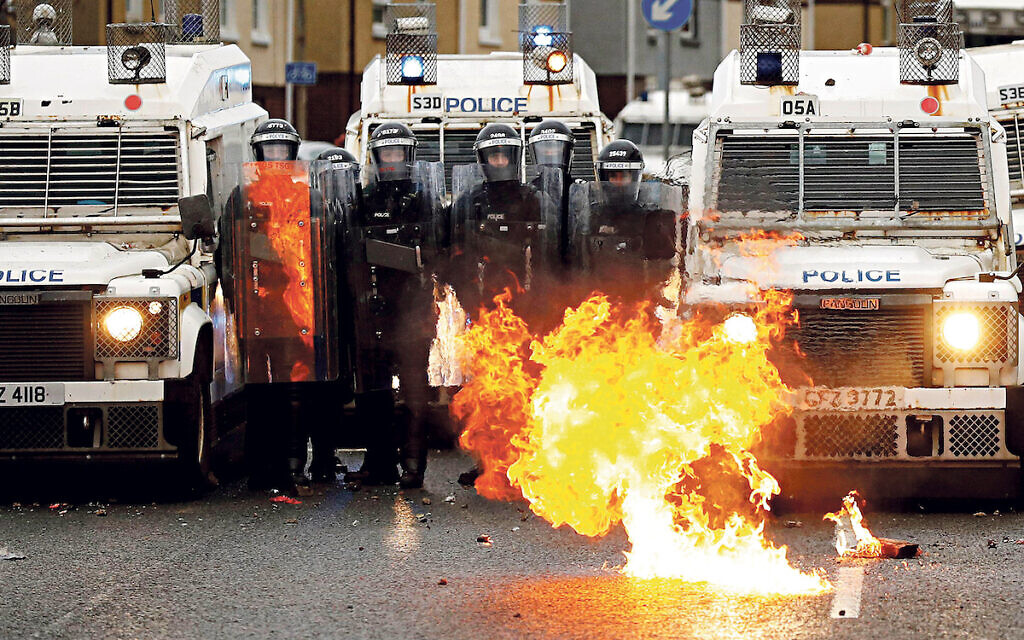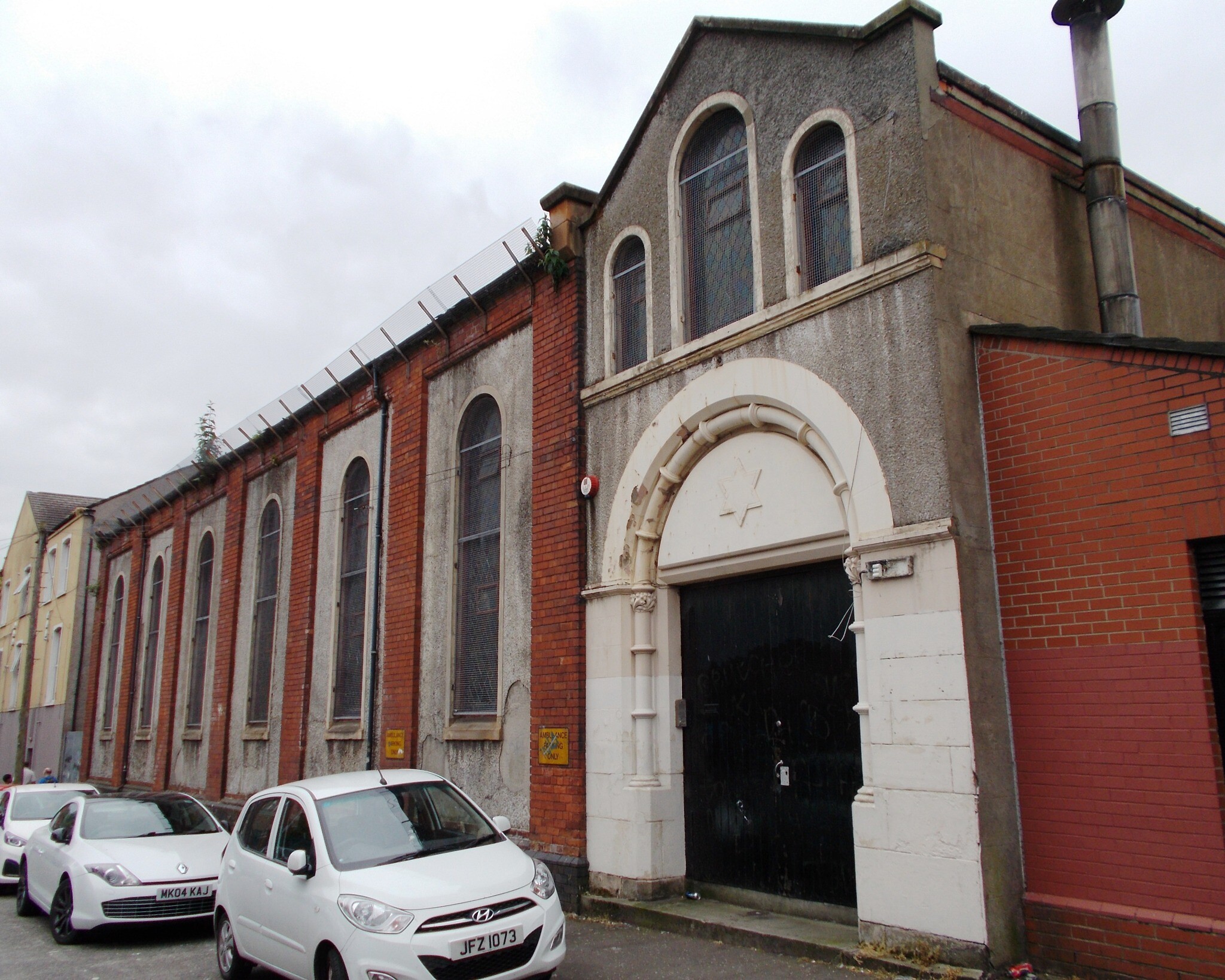The Troubles we’ve seen
At the height of Northern Ireland’s religious violence – flaring again on Belfast’s streets – Jews found sanctuary in ‘the club’, a short walk from the synagogue

This month, Northern Ireland’s capital has been plagued by familiar scenes: rioting, the grey shells of burned-out cars and injured police officers.
For many in this post-industrial city of 280,000, it has conjured memories of the Troubles, the three decades of sectarian violence that left thousands dead and pushed thousands of others to leave.
But, as it was throughout the worst of the Troubles, Belfast’s tiny Jewish community – which is down to about 30 households from a peak of 453 in 1977 – is not too concerned about the new conflict, which has boiled over owing to Brexit complications and other unresolved British-Irish tensions.
Get The Jewish News Daily Edition by email and never miss our top stories Free Sign Up
Michael Black, the community’s chairman, told the Jewish Telegraphic Agency last week that he hopes the violence will “peter out” soon.
“Thankfully, the few areas that are rioting are not near the shul or where the Jewish community live. We only feel threatened when there is a problem in the Middle East,” he said, referencing the anti-Israel sentiment that runs strong throughout Ireland.
Just like in the 1970s, the feuding protesters are broadly split into two groups: Irish Republicans, who want a united Ireland, and British loyalists, who want Northern Ireland to remain a part of the United Kingdom. The loyalists, angered by part of the Brexit deal that has set up a trade barrier in the Irish Sea, have been the main instigators of the current protests. The trade wall has effectively left Northern Ireland using European Union market rules, leaving many infuriated loyalists feeling like the country is treated differently than the rest of the UK.

The last straw for them was a large funeral for IRA member Bobby Storey, which drew lawmakers and disregarded social distancing guidelines, despite taking place at the height of the pandemic. But there is also an ethno-religious divide between the two sides: the Irish Republicans are largely Catholic, the loyalists largely Protestant.
Because local Jews avoided taking a side on the religious front, they have been – and still are – seen as neutral onlookers. In some cases, they were even involved in attempts at reconciliation between the two groups. But this doesn’t mean the Jewish community came out completely unscathed although, as 1970 dawned and Belfast was plunged into violence, the city’s Jewish community was thriving in a social sense.
Former member Keith Daly said growing up Jewish at the time felt “like the shtetl from Russia moved to Belfast … so when we grew up, it just felt like family”.
Many Northern Irish Jews were the descendants of Ashkenazim who had fled pogroms in Eastern Europe and, later, the Holocaust. Some decided to settle and build a community there instead of making the journey across the Atlantic.
Many have attributed the success of the community to the Belfast Jewish Institute (“the club”), which was a short walk from the synagogue on a leafy street in the northern part of the city. It offered its members tennis courts, a ballroom, card rooms, a drama society, a debating society, a kosher restaurant and more. It entertained esteemed guests, such as ceremonial lord mayors and chief rabbis.

While the city around it occasionally erupted into literal flames, or the sound of bombs blowing up could be heard nearby, the club acted as a sanctuary for the Belfast Jewish community.
For a provincial area that struggled to attract any tourism during the conflict, Belfast had everything going for its tight-knit Jewish community in the early ’70s: a synagogue that was full every week; a booming social life at the club; and amenities not found in other small communities in Great Britain, such as a kosher butcher who came to the doorsteps of Jewish families in the city’s northern part.
Staying out of the conflict allowed community members to relatively prosper financially, and they were held in high esteem throughout the Troubles for their important contributions to Belfast over time. For example, a Jewish family was instrumental in Northern Ireland’s booming linen industry, which cemented Belfast as an enviable industrial city in the 19th century. Later on, many Northern Irish Jews owned family-run businesses, and became doctors and other professionals.
If it seemed too good to be true, it was. Some 3,700 people died in the conflict, many of them uninvolved civilians, and eventually it hit the Jewish community.
On 8 February 1980, Leonard Kaitcer, a husband with two sons and a beloved member of Belfast’s Jewish community, was dragged from his home and kidnapped by gunmen. He was an antiques dealer who owned a shop in the city and his kidnappers had demanded a £1 million ransom for his release. When Kaitcer was unable to hand it over, he was shot dead.
While no paramilitary ever took responsibility for the murder, kidnapping was a tactic employed by many Irish Republican groups as part of a campaign to devastate the British state and its economy, and to fund its weaponry.
For many Jewish families, moments like these became the final impetus to leave Belfast. Expatriate Gillian Rowe Price remembers being “whisked away” by her parents at short notice to Manchester, which has a far larger Jewish population. Other families followed suit.
In 1977, there were 453 households affiliated with the synagogue in north Belfast, Northern Ireland’s only Jewish house of worship. In 1983, there were 312. By 1990, the number had dropped to 221. Today there are just over 30.
As the community began to decline at a steeper rate – arguably in the early 1980s, when the Troubles were at their peak – the Belfast Jewish Record reported that “each departure is a grievous loss to the small community, one which we can ill afford”. “The cumulative effect is serious and will inevitably bring about much soul-searching,” it continued. “The whole future of this community is now in a state of flux and its condition must be continuously under review.”
Northern Ireland’s Jewish community is one “dying on its feet”, said Jerusalem-born Shoshana Appleton, wife of Belfast-born Jew Ronnie Appleton, who was chief prosecutor for Northern Ireland for 22 years. But, she adds: “A lot of people wouldn’t believe you, but it’s a lovely place.”

Thank you for helping to make Jewish News the leading source of news and opinion for the UK Jewish community. Today we're asking for your invaluable help to continue putting our community first in everything we do.
For as little as £5 a month you can help sustain the vital work we do in celebrating and standing up for Jewish life in Britain.
Jewish News holds our community together and keeps us connected. Like a synagogue, it’s where people turn to feel part of something bigger. It also proudly shows the rest of Britain the vibrancy and rich culture of modern Jewish life.
You can make a quick and easy one-off or monthly contribution of £5, £10, £20 or any other sum you’re comfortable with.
100% of your donation will help us continue celebrating our community, in all its dynamic diversity...
Engaging
Being a community platform means so much more than producing a newspaper and website. One of our proudest roles is media partnering with our invaluable charities to amplify the outstanding work they do to help us all.
Celebrating
There’s no shortage of oys in the world but Jewish News takes every opportunity to celebrate the joys too, through projects like Night of Heroes, 40 Under 40 and other compelling countdowns that make the community kvell with pride.
Pioneering
In the first collaboration between media outlets from different faiths, Jewish News worked with British Muslim TV and Church Times to produce a list of young activists leading the way on interfaith understanding.
Campaigning
Royal Mail issued a stamp honouring Holocaust hero Sir Nicholas Winton after a Jewish News campaign attracted more than 100,000 backers. Jewish Newsalso produces special editions of the paper highlighting pressing issues including mental health and Holocaust remembrance.
Easy access
In an age when news is readily accessible, Jewish News provides high-quality content free online and offline, removing any financial barriers to connecting people.
Voice of our community to wider society
The Jewish News team regularly appears on TV, radio and on the pages of the national press to comment on stories about the Jewish community. Easy access to the paper on the streets of London also means Jewish News provides an invaluable window into the community for the country at large.
We hope you agree all this is worth preserving.
-
By Laurent Vaughan - Senior Associate (Bishop & Sewell Solicitors)
-
By Laurent Vaughan - Senior Associate (Bishop & Sewell Solicitors)
-
By Laurent Vaughan - Senior Associate (Bishop & Sewell Solicitors)
-
By Laurent Vaughan - Senior Associate (Bishop & Sewell Solicitors)





















